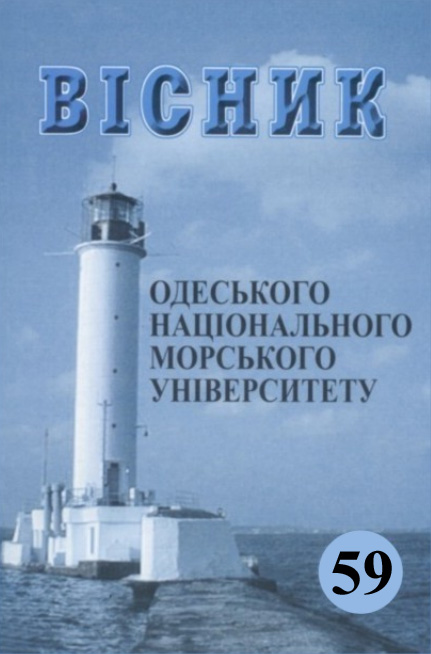Maple® symbolic mathematics system in projections for discrete optimization problems
Main Article Content
Abstract
This research provides a way for simplifying the combinatory solution of a discrete optimization problem. It is based on decomposition of the system that represents the system constraining a multidimensional output problem to the two-dimensional coordinate plane. Such method allows obtaining a simple system of graphical solutions of a complicated linear discrete optimization problem. The automation of calculations in the Maple® environment provides the basis for further development and improvement of such algorithms, and for using in teaching a number of disciplines in education programs on IT project management aimed at Master’s degree.
Article Details
How to Cite
ChernovаL. (2020). Maple® symbolic mathematics system in projections for discrete optimization problems. Herald of the Odessa National Maritime University, (59(2), 214-235. https://doi.org/10.33082/2226-1915-2-2019-214-235
Section
Project and program management
References
1. Korbut А.А., Finkelstein Y.Y. (1969). Dyskretnoe programmyro-vanye [Discrete programming]. Moscow: Nauka [in Russian]
2. Finkelstein Y.Y. (1976). Priblizhennyie metodyi i prikladnyie zadachi diskretnogo programmirovaniya [Approximate methods and applied problems of discrete programming]. Moscow: Nauka [in Russian]
3. Wagner H. (1973). Osnovyi issledovaniya operatsiy [Principles of Operations Research]. Moscow: Mir, 1973.
4. Burkov V.N., Gorgidze I.А., Lovetskiy S.Е. (1974). Prikladnyie zadachi teorii grafov [Applied problems of the theory of graphs]. Tbilisi: Computation Centre of Republican Adacemy of Science of Georgian SSR.
5. Sigal I.K., Ivanova A.P. (2003). Vvedenie v prikladnoe diskretnoe programmirovanie: modeli i vyichislitelnyie algoritmyi [Intro-duction to applied discrete programming: models and calculation algorithms]. Moscow.
6. F. Nozicka, J. Guddat, H. Hollatz. (1972). The Linear Opti-mization Theory. Berlin.
7. Titov S.D., Chernova L.S. (2017). Vyshcha ta prykladna matematyka [Higher and applied mathematics]. Manual: In 2 parts, Part 1, Kharkiv, Fakt.
8. Lau D. (2007). Algebra and Discrete Mathematics 1. Basic Terms of Mathematics, Algebraic Structures 1,Linear Algebra and Analytic Geometry, Numeric Algebra. Second corrected and supplement ededition. Berlin: Springer.
9. Jean Pierre David (2017). Low latency and division free Gauss-Jordan solver in floating pointarithmetic. Journal of Parallel and Distributed Computing, 106, 185-193.
10. Lax Peter D. (2007). Linear algebra and application. New York, Wiley, 2-nd ed.
11. Yeremin I. I., Astafiev N. N. (1976). Vvedenie v teoriyu lineynogo i vyipuklogo programmirovaniya [Introduction to the theory of linear and convex programming]. Moscow: FIZMATLIT.
12. Tytov S.D., Chernova L.S. (2016). Teoriia vyznachnykiv: Navchalno- metodychnyi posibnyk [Theory of determinants: Trai-ning and methodological manual]. Mykolaiv: Torubara V.V.
13. Teschl Gerald, Teschl Susanne. (2008). Mathematics for Infor-mation Scientists. Volume 1: Discrete Mathematics and Linear Algebra. Berlin, Springer.
14. Buhir M.K. (1998). Matematyka dlia ekonomistiv. Liniina alhebra, liniini modeli [Mathematics for economists. Linear algebra, linear models]. Kyiv.
15. Buhir M.K. (2003). Matematyka dlia ekonomistiv [Mathematics for economists]. Alma-matir Academia, 2003.
16. Titov S.D., Chernov S.K., Chernova L.S. (2018). Reduction in Discrete Optimization Problem, 2018 IEEE 13th International Scientific and Technical Conference on Computer Sciences and Information Technologies, CSIT 2018.
17. Chernov S., Titov S., Chernova L., (...), Chernova L., Kolesni- kova K. Algorithm for the simplification of solution to discrete optimization problems Eastern-European Journal of Enterprise Technologies.
18. Kovalev М.М. (1977). Diskretnaya optimizatsiya [Discrete optimization]. Minsk: Byelorussian State University.
2. Finkelstein Y.Y. (1976). Priblizhennyie metodyi i prikladnyie zadachi diskretnogo programmirovaniya [Approximate methods and applied problems of discrete programming]. Moscow: Nauka [in Russian]
3. Wagner H. (1973). Osnovyi issledovaniya operatsiy [Principles of Operations Research]. Moscow: Mir, 1973.
4. Burkov V.N., Gorgidze I.А., Lovetskiy S.Е. (1974). Prikladnyie zadachi teorii grafov [Applied problems of the theory of graphs]. Tbilisi: Computation Centre of Republican Adacemy of Science of Georgian SSR.
5. Sigal I.K., Ivanova A.P. (2003). Vvedenie v prikladnoe diskretnoe programmirovanie: modeli i vyichislitelnyie algoritmyi [Intro-duction to applied discrete programming: models and calculation algorithms]. Moscow.
6. F. Nozicka, J. Guddat, H. Hollatz. (1972). The Linear Opti-mization Theory. Berlin.
7. Titov S.D., Chernova L.S. (2017). Vyshcha ta prykladna matematyka [Higher and applied mathematics]. Manual: In 2 parts, Part 1, Kharkiv, Fakt.
8. Lau D. (2007). Algebra and Discrete Mathematics 1. Basic Terms of Mathematics, Algebraic Structures 1,Linear Algebra and Analytic Geometry, Numeric Algebra. Second corrected and supplement ededition. Berlin: Springer.
9. Jean Pierre David (2017). Low latency and division free Gauss-Jordan solver in floating pointarithmetic. Journal of Parallel and Distributed Computing, 106, 185-193.
10. Lax Peter D. (2007). Linear algebra and application. New York, Wiley, 2-nd ed.
11. Yeremin I. I., Astafiev N. N. (1976). Vvedenie v teoriyu lineynogo i vyipuklogo programmirovaniya [Introduction to the theory of linear and convex programming]. Moscow: FIZMATLIT.
12. Tytov S.D., Chernova L.S. (2016). Teoriia vyznachnykiv: Navchalno- metodychnyi posibnyk [Theory of determinants: Trai-ning and methodological manual]. Mykolaiv: Torubara V.V.
13. Teschl Gerald, Teschl Susanne. (2008). Mathematics for Infor-mation Scientists. Volume 1: Discrete Mathematics and Linear Algebra. Berlin, Springer.
14. Buhir M.K. (1998). Matematyka dlia ekonomistiv. Liniina alhebra, liniini modeli [Mathematics for economists. Linear algebra, linear models]. Kyiv.
15. Buhir M.K. (2003). Matematyka dlia ekonomistiv [Mathematics for economists]. Alma-matir Academia, 2003.
16. Titov S.D., Chernov S.K., Chernova L.S. (2018). Reduction in Discrete Optimization Problem, 2018 IEEE 13th International Scientific and Technical Conference on Computer Sciences and Information Technologies, CSIT 2018.
17. Chernov S., Titov S., Chernova L., (...), Chernova L., Kolesni- kova K. Algorithm for the simplification of solution to discrete optimization problems Eastern-European Journal of Enterprise Technologies.
18. Kovalev М.М. (1977). Diskretnaya optimizatsiya [Discrete optimization]. Minsk: Byelorussian State University.
